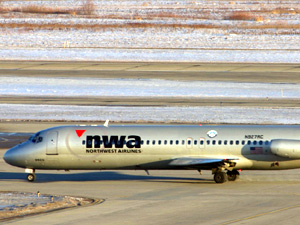|
Photos
More from MPR
|
February 21, 2005
Minneapolis, Minn. — (AP) Every weekday, a little piece of aviation history takes off in Columbus, Ohio. And Buffalo, N.Y., and dozens of other cities where Northwest flies DC-9s that average 34 years old. Some of them first flew when Lyndon Johnson was president.
Northwest's DC-9s tie it for the oldest fleet among the world's 60 largest airlines, even as Northwest adds new planes. Analysts say Northwest's 1995 decision to gut and refurbish those DC-9s rather than replace them is helping it weather high fuel prices and competition from low-cost carriers better than most major carriers.
Unlike most other airlines, Northwest owns a significant chunk of its fleet outright. Northwest says that has given it the flexibility to park unneeded planes during travel slowdowns like those during the Iraq war and the SARS epidemic.
"Putting a plane down is much different when you own it than when you're paying $330,000 per month" in debt payments for a new airplane, said Tom Bach, Northwest's vice president of market planning, who was closely involved in the research that went into the decision to refurbish the DC-9s.
Joel Denney, an airline analyst at Piper Jaffray in Minneapolis, agreed. "In a really difficult environment, you want to have very low fixed costs," he said.
Certainly, Northwest still has problems. It's pressing for labor concessions and recently announced it would eliminate free meals in coach on all domestic flights. But while it's losing money, the airline still had $2.46 billion in cash at the end of 2004 and has avoided bankruptcy, unlike some if its competitors.
Northwest's reliance on DC-9s - the aircraft accounts for more than a third of its 432-plane fleet - gives it an average plane age of about 18 years, according to data provided by BACK Aviation Solutions of New Haven, Conn. That ties with Aerolineas Argentinas for the oldest fleet among the world's top 60 airlines, according to BACK.
By contrast, the average plane age of the other five hub-and-spoke airlines is about 10 years old. Continental, which went on a buying spree in the late 1990s, has a fleet that averages just eight years old.
Northwest's fleet is so old, "it's the airline probably most worried about President Bush's Social Security proposal," cracked George Hamlin, director at airline consulting firm MergeGlobal Inc. "Northwest has chosen to be a contrarian in terms of keeping these aircraft much longer than anyone expected."
The safety of the planes isn't an issue because of federally required maintenance, said Ed Greenslet, publisher of the Airline Monitor trade journal.
The Federal Aviation Administration doesn't care how old an aircraft is, just how many times it has been flown. It measures that by the number of times it has been pressurized and de-pressurized - generally, once per flight. The DC-9, based on testing, is approved for 105,000 of these cycles.
Bach said some of Northwest's DC-9s are hitting that limit and being retired. In January, the company said it would retire 10 DC-9s this year.
In 1995, Eagan-based Northwest began updating its DC-9s, gutting the interiors and installing new carpeting, lavatories, and seats. It also upgraded the planes' electronic and mechanical systems and installed "hush kits" so the engines comply with noise limits.
Bach said comparable new planes at the time were running around $30 million, and the upgrades cost a fraction of that, though he said he wasn't sure exactly how much.
Delta Air Lines and Continental Airlines and US Airways all used to fly DC-9s. Delta replaced its DC-9s in the 1980s, and Continental and US Airways followed suit in the 1990s, Hamlin said. Some wanted bigger planes, and others wanted planes that could be flown by pilots already trained on other aircraft. But Northwest has so many DC-9-trained pilots that that's not a factor, he said.
Many of the DC-9s are outfitted with around 100 seats - just right for midsize markets such as Columbus, Ohio or Buffalo, N.Y. where a larger plane would risk having too many empty seats.
Airplane buying used to be driven by money-saving design changes such as more efficient engines or cockpits that required two crew members instead of three, Hamlin said. The DC-9s meet those requirements, including the two-person cockpit, Hamline said, so why replace them?
"It's a rugged airplane that's got a reputation for durability," he said.




